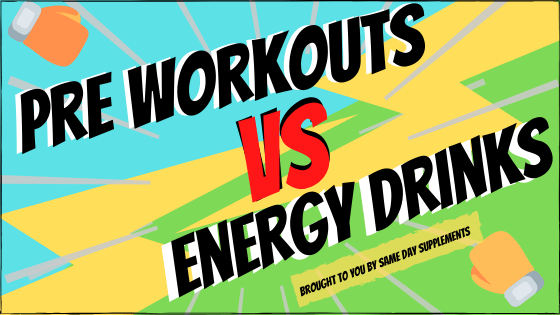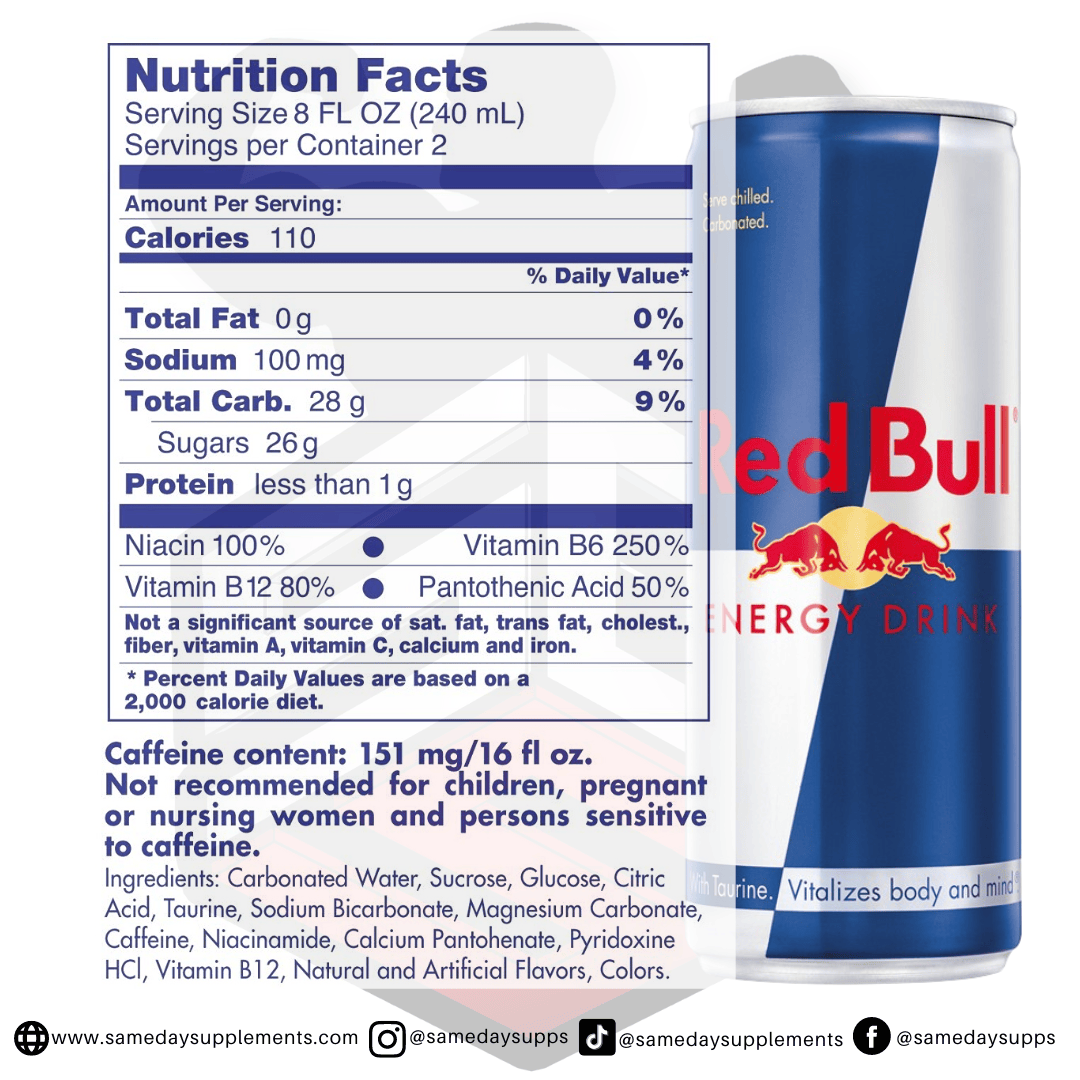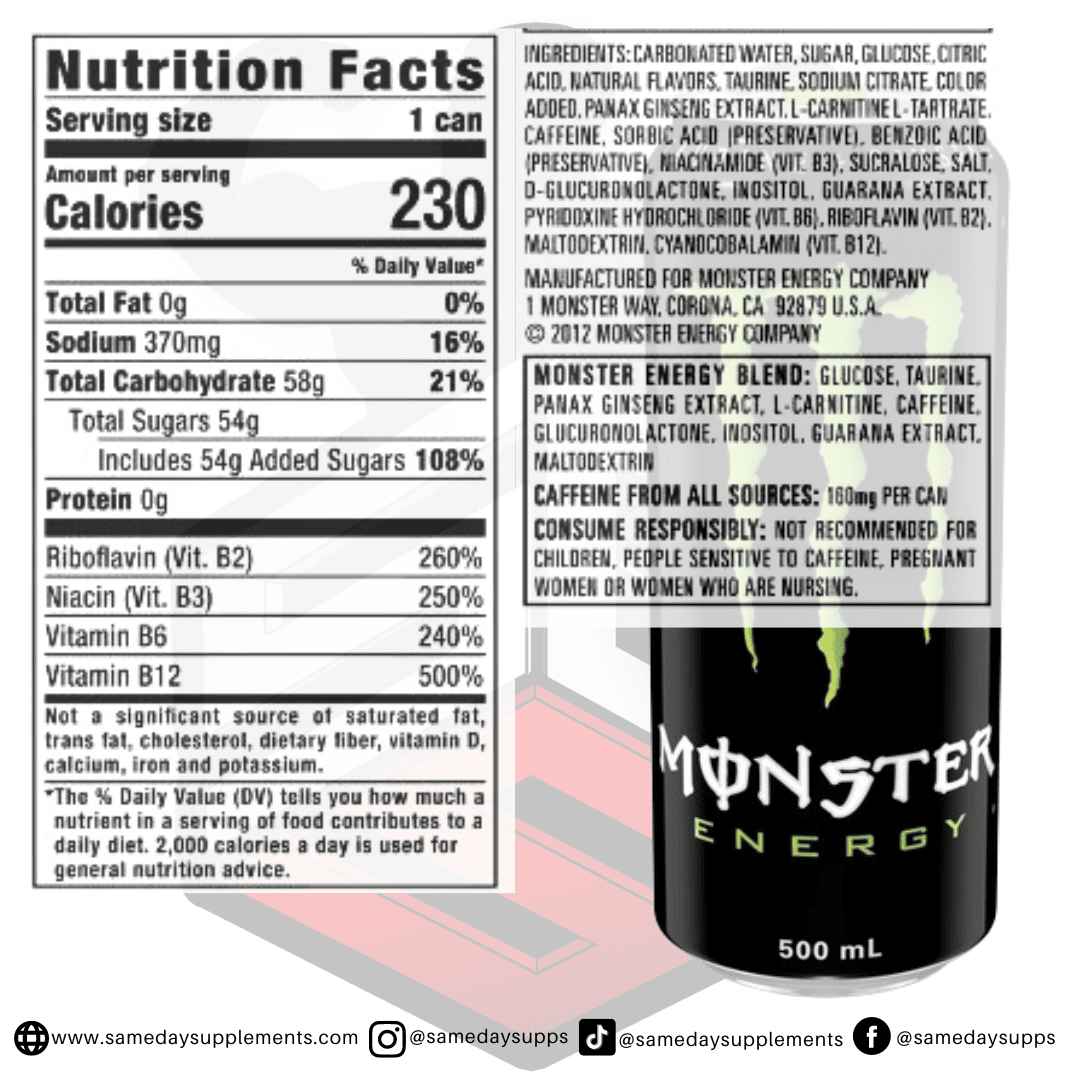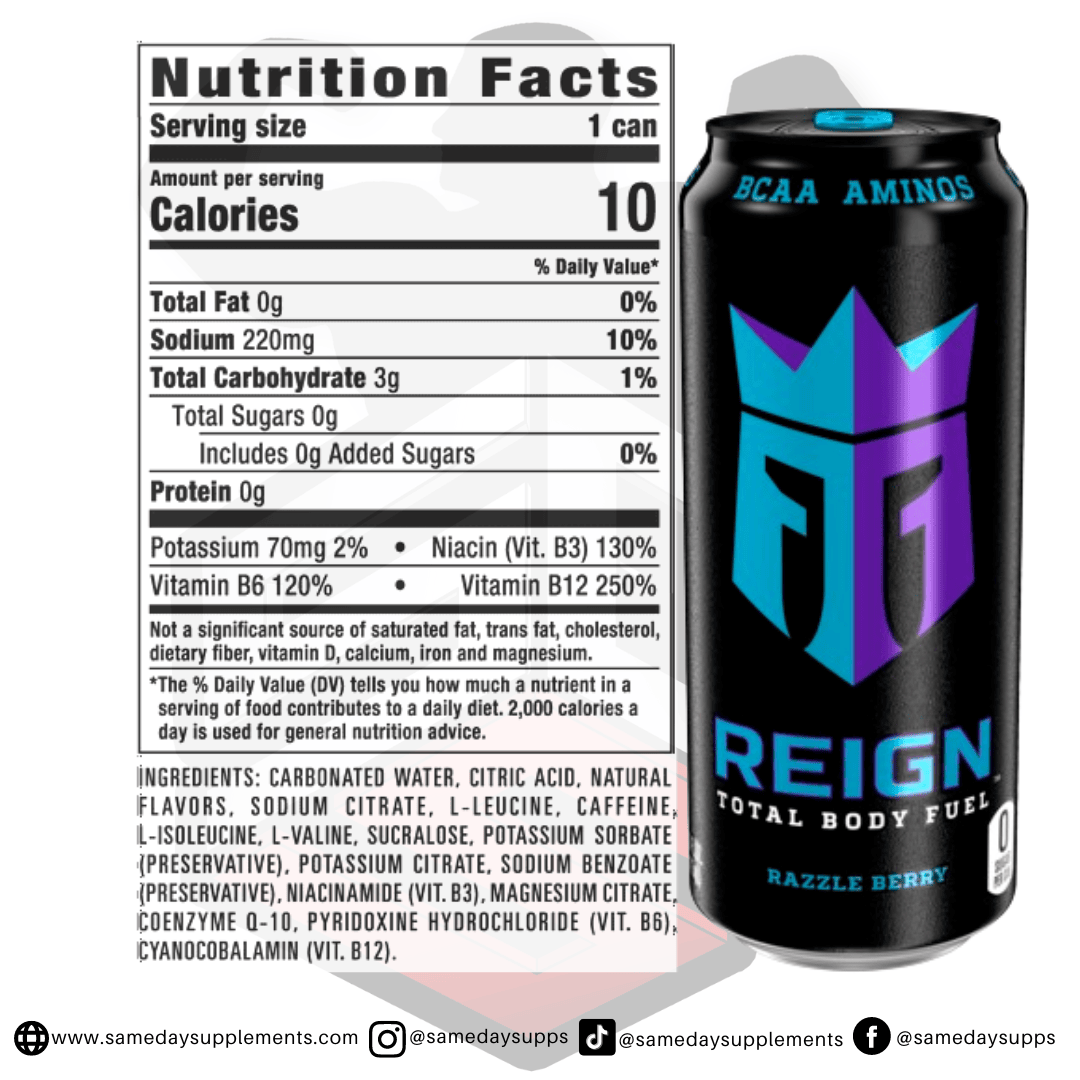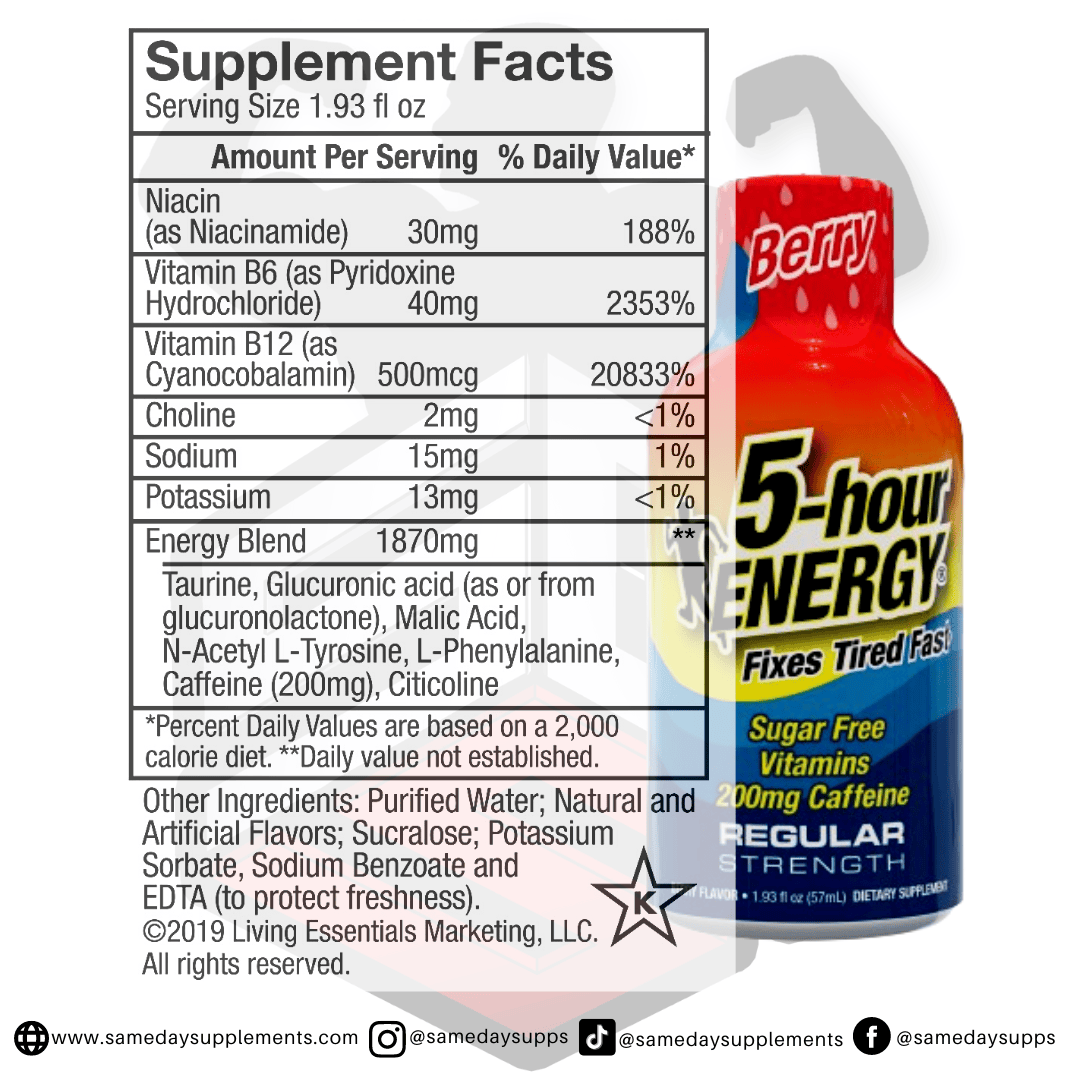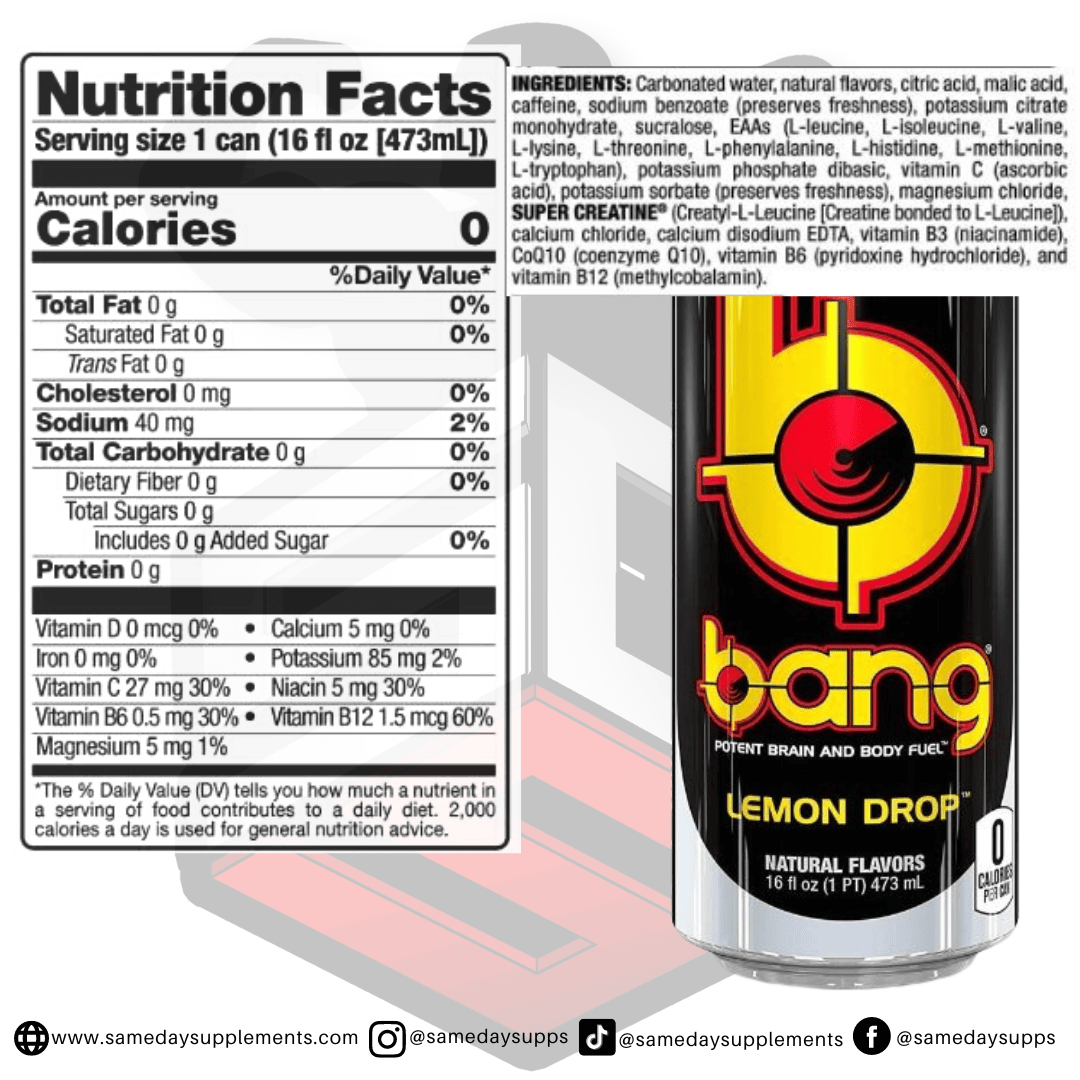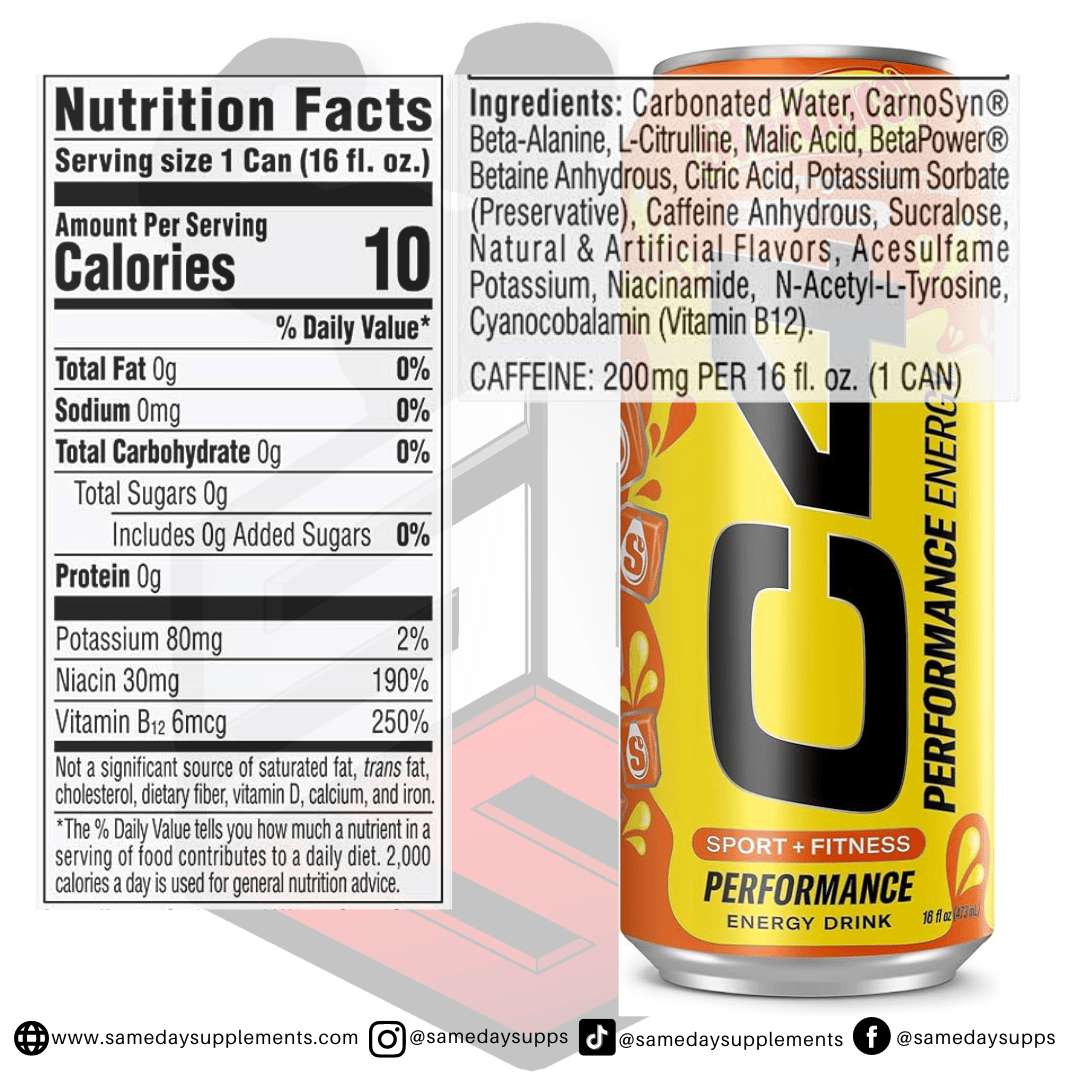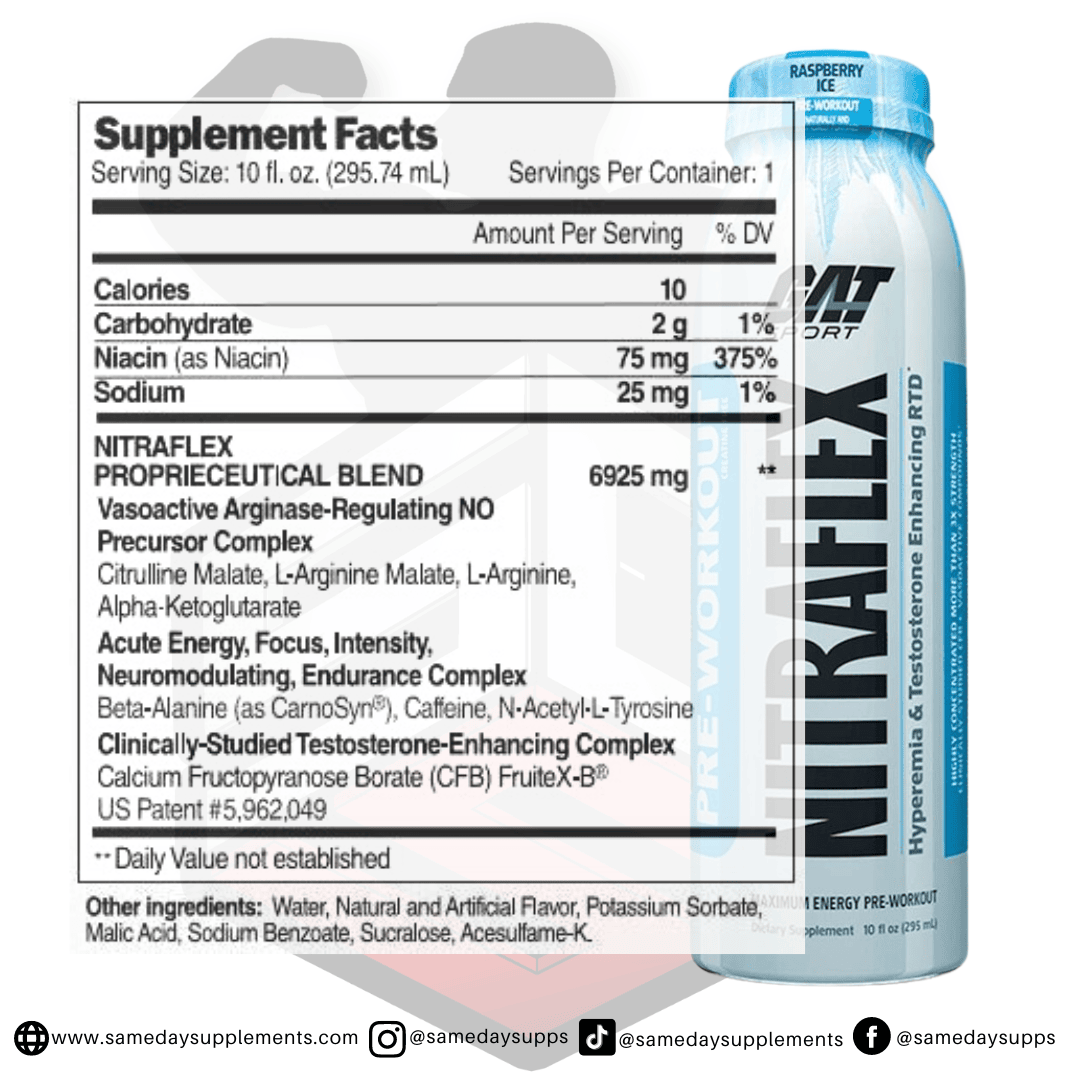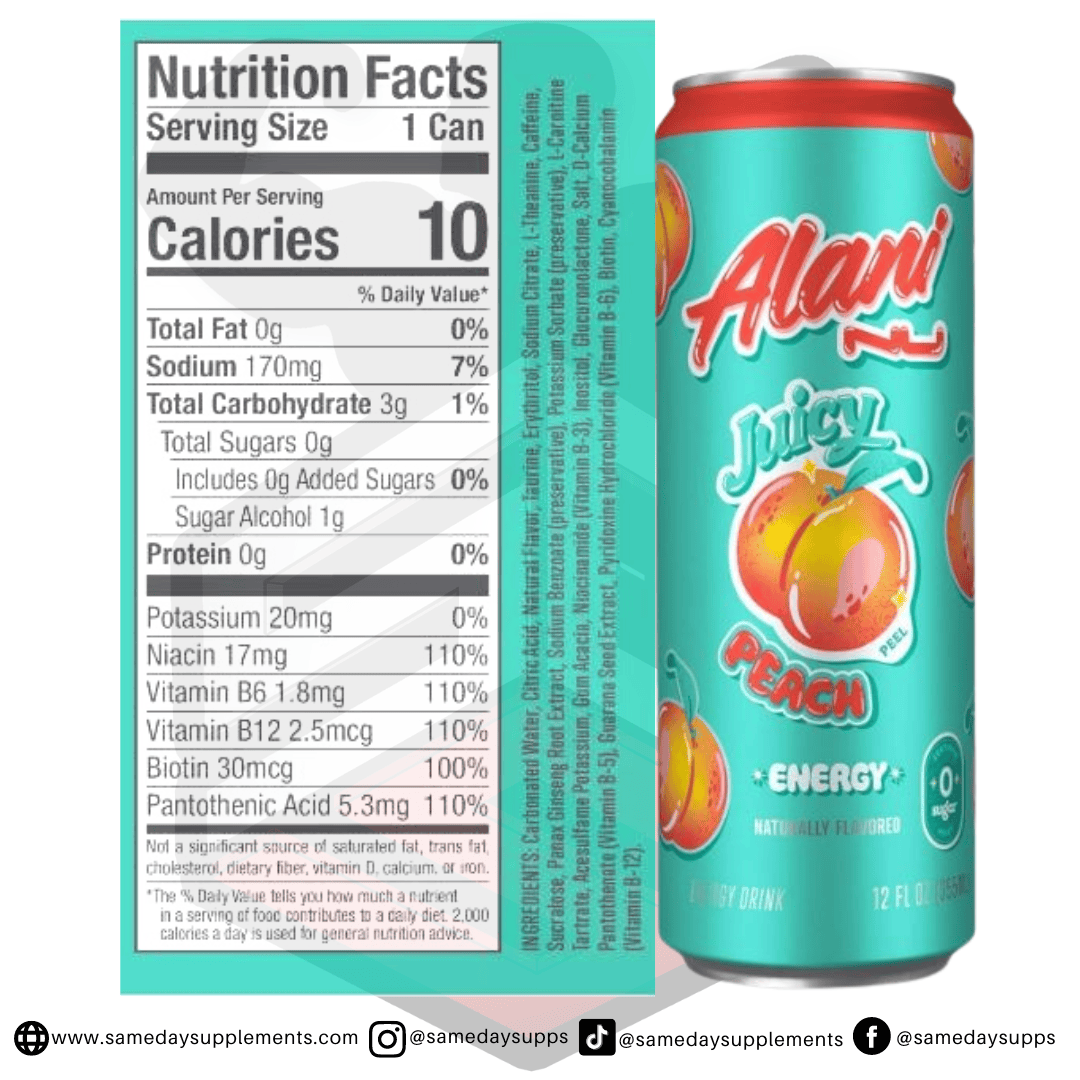Pre Workout VS Energy Drink
Are Energy Drinks & Pre Workouts Healthy | Popular Energy Drinks | Popular Pre Workouts | Which Is More Effective For The Gym | How To Get The Most Bang For Your Buck | Wrapping Up | Side Effects and Warnings | Disclaimer
It’s 2024, and with the new year, we would like to reflect on what’s different and what’s to come. From streaming service wars to energy drinks, it’s hard to keep up with all the new and old companies. That’s where we come in! In this post, we’re covering some of your favorite energy drinks (like Reign™ and Monster) and their competition: the ready-to-drink (RTD) pre workout!
We’re going to go as in-depth as possible, but we may run into some proprietary blends along the way. So, we will do our best to generalize across products when possible.
Pre Workout VS Energy Drink: What’s Considered Healthy?
This is actually kind of a difficult question to answer, mainly because health is different for everyone.
Before we can start comparing products, we have to have a baseline of what’s ideal in our version of healthy. In our ideal energy drink, we have potent sources of energy and focus, BCAAs and/or Electrolytes (for re-hydration and muscle repair), low calories or no calories, and some great flavors without the after-a-energy-drink aftertaste.
Let’s also tackle some of the common features of RTD products.
Preservatives:
Preservative ingredients are used to prevent deterioration and spoilage. It also helps extend shelf life.
Physical methods to preserve foods and beverages include freezing, refrigerating and/or drying. The other method of preservation is through chemicals. Chemical preservation involves “additives”, but there are many naturally occurring chemical preservatives such as salts.
Some common chemical preservatives include:
- Benzoates
- Sorbates, including potassium sorbate, calcium sorbate and sodium sorbate
- Propionates
- Nitrites
- Sulfites, including sodium sulfite, sodium bisulfite, sodium metabisulfite, potassium bisulfite and potassium metabisulfite.
- Vitamins, including Vitamin E (tocopherol) and Vitamin C (ascorbic acid)
- Disodium ethylenediaminetetraacetic acid/Calcium Disodium (EDTA)
- Polyphosphates- Phosphoric acid is often used in drinks to aid in flavor (adding a tanginess to the drink) and doubles as a preservative.
- Citric Acid
- Magnesium Lactate
- Citrates, including potassium citrate and sodium citrate
Sugar, Sweeteners, and Flavoring!
The FDA has approved five artificial sweeteners: saccharin, acesulfame, aspartame, neotame, and sucralose.
As you can imagine, there’s more to artificial sweeteners than being a sugar alternative. In fact, one animal study suggests that artificial sweetener may be addictive. (1) In general, it appears that there is a lapse in research on the long term usage of artificial sweeteners. However, there are risks associated with daily consumption of drinks with high volumes of artificial sweeteners, including metabolic syndrome and type 2 diabetes.
So what about regular sugar?
Sugar contains its own set of risks including increasing blood glucose levels and insulin, inflammatory mediators, triglyceride and other conditions.
In pre workouts and energy drinks, you can find a combination of natural and artificial sweeteners. These include the following:
Sucrose & Glucose
Sucrose is a disaccharide consisting of glucose and fructose. Glucose is a simple sugar or monosaccharide. It’s your body’s preferred carb-based energy source. (2)
Maltodextrin
Maltodextrin is a common additive in processed foods made of corn, rice, potato starch, or wheat. It is very similar to corn syrup but with less sugar content. This ingredient serves several purposes; it’s a sweetener, a thickener, and a preservative.
While the FDA has approved of maltodextrin as a safe ingredient, it is high in the glycemic index, meaning it can cause a spike in blood sugar. So anyone with diabetes should be cautious of how much maltodextrin they intake. (3)
Acesulfame Potassium
Acesulfame potassium (Ace-K) is a sweetener that is generally said to be sweeter than table sugar. Because it is a non-sugar sweetener, it is often used in products that are sugar-free or low-sugar. There is a controversy over the safety of Ace-K, however, the FDA has maintained that it is safe for consumption. (4)
Erythritol
Erythritol is a type of sugar alcohol that is considered safe. It does not appear to have serious side effects, but consuming too much of it may cause an upset stomach. †
What about natural and artificial flavoring?
The FDA defines natural flavors as any flavor isolated from natural sources like plants. Whereas artificial flavors are any flavors not isolated from natural sources, even if they have the exact chemical composition of natural flavors. Believe it or not, many experts say that natural and artificial flavors aren’t that different. And that the drive to use natural flavors over artificial is more for marketing purposes. (5)
Popular Energy Drinks:
With that all said, let’s start comparing! For the purpose of the post, we’ll be covering the most popular flavors/styles of these products. So there may be variations between products within a brand/series.
- Red Bull®
- Monster
- Reign™
- 5-Hour Energy
Red Bull®
Red Bull® is one of the most popular energy drinks and has been for years. It features a moderate amount of caffeine to help you feel awake without feeling jittery.
Red Bull® Ingredients include:
- Carbonated Water
- Sucrose
- Glucose
- Citric Acid
- Taurine
- Sodium Bicarbonate
- Magnesium Carbonate
- Caffeine
- Niacinamide
- Calcium Pantothenate
- Pyridoxine HCl
- Vitamin B12
- Natural and Artificial Flavors
- Colors
Caffeine(6)
Caffeine is a central nervous system (CNS) stimulant. When it is consumed and reaches your brain, you’ll notice the effects like energy and alertness. Because of this effect you can find caffeine in a wide range of products and medications.
But, caffeine also has some side effects. Too much caffeine can lead to headaches and jitters, as well as high blood pressure and even building a tolerance. Like most stimulants, when you build tolerance to caffeine, you’ll need more of it to gain the same benefits someone who isn’t tolerant would have.
That’s why it’s important to cycle your caffeine usage. When you don’t cycle your caffeine, you create a dependence for it. And here’s the thing, like most stimulants, caffeine is a drug and it’s a drug you can be addicted to. So the day you do forget your morning coffee or Red Bull®, you can be greeted by some withdrawal symptoms like anxiety, irritability, and drowsiness (7)
Dosages:
Caffeine is considered to be safe for consumption at up to 400 mg (around 4 cups of coffee) by the Mayo Clinic. Per 250 ml can of Redbull, there is 80 mg of caffeine.
Taurine
Taurine is an amino acid found commonly in the brain. It serves multiple purposes in the body, including (8):
- Maintaining hydration and electrolytes
- Regulates minerals such as calcium
- Supports the nervous system and eyes
- Regulate immune system functions
But taurine may also boost exercise performance. Studies suggest that taurine may aid in removing waste products that lead to fatigue and muscle burn. What this translates to is it is effective in promoting endurance, increasing alertness, and enhancing recovery. (9)
Dosage:
Taurine may be efficient when dosed at 500 to 3000mgs. (10)
Sodium Bicarbonate(11)
The next ingredient is something we all have somewhere in our homes: sodium bicarbonate, aka baking soda. So why have it in Redbull? Sodium bicarbonate may actually help improve performance in high-intensity exercises (more research is needed). It also improves muscle coordination and increases strength. (12)
Dosage:
Sodium bicarbonate is effective when dosed at 90 to 135 mg.
Magnesium Carbonate
Magnesium has a ton of functions in the body, from energy creation to genetic maintenance. So it should come as no surprise it plays a role in exercise performance as well. Results are mixed within the studies, so we would need more evidence to be definitive about what aspects are being improved. (13,14,15) Magnesium Carbonate, however, is used in products as a drying agent† and is a common over-the-counter remedy for heartburn and upset stomach (16).
Dosage:
The standard dose for magnesium is 200 to 400mg.†
Monster:
The next energy drink we’re going over is Monster. Monster’s formula features a little more ingredients than Red Bull® and almost doubles the serving size.
Monster’s Ingredients include:
- Carbonated Water
- Sucrose
- Glucose
- Citric Acid
- Natural Flavors
- Taurine
- Sodium Citrate
- Color Added
- Panax Ginseng Extract
- L-Carnitine L Tartrate
- Caffeine
- Sorbic Acid
- Benzoic Acid
- Niacinamide
- Sucralose
- Salt
- D-Glucuronolactone
- Inositol
- Guarana Extract
- Pyridoxine HCl
- Riboflavin
- Maltodextrin
- Cyanocobalamin
But, there are several ingredients that we’ve already gone over. This includes:
- Sucrose(Sweetener)
- Glucose(Sweetener)
- Citric Acid (Preservative)
- Taurine
- Sodium Citrate (Preservative)
- Caffeine (160mg per can)
- Sorbic Acid (Preservative)
- Benzoic Acid (Preservative)
- Sucralose(Sweetener)
Which leaves:
- L-Carnitine L-Tartrate
- Salt
- D-Glucuronolactone
- Guarana Extract
- Panax Ginseng Root Extract
- Inositol
L-Carnitine L-Tartrate
L-carnitine plays a crucial role in energy production by transporting fatty acids into your cells’ mitochondria. Where your mitochondria use these acids to create energy. (17)
There is also evidence (though mixed) that L-carnitine l-tartrate may benefit exercise performance. This may be through enhancing recovery, increasing oxygen supply, improving stamina, and reducing muscle soreness. (18,19)
Dosage:
Doses of 2 grams or less are considered safe for most people. There are some potential side effects, including nausea and stomach discomfort. (20)
Salt(21)
Because sodium is a major salt in sweat, drinks may include sodium or other versions of salt to aid in rehydration.
Dosage:
Research suggests that consuming about 450 mg or more sodium per hour of exercise is needed to maintain plasma volume and sodium levels.
D-Glucuronolactone
Glucuronolactone is a sugar acid that is naturally occurring in the body. This is a common ingredient found in energy drinks and pre workouts alike, but what it does isn’t very clear. There are some studies that suggest it may improve energy and alertness, but more research is needed to support this. (22)
Guarana Extract
Guarana is a plant native to the Amazon with seeds that may contain four times more caffeine than coffee beans. Because of this, guarana may promote the same effects of caffeine. This includes improving energy, alertness, and may even improve metabolism. (23)
Dosage:
One of the best aspects of guarana extract is that a little goes a long way. The cognitive benefits have been noted at doses as low as 37mg to as high as 300mg. (24)
Panax Ginseng Root Extract
Panax Ginseng is a slow-growing root that has been used in Chinese medicine for centuries. There are several beneficial functions of ginseng, but one that we’re most interested in is the brain functions. Studies suggest ginseng could help improve cognitive functions like memory, social functioning, and mood. (25)
Dosage:
Studies suggest that dosages from 200 to 400mg is effective for improving mental performance and calmness. (26,27)
Inositol
Inositol is a type of sugar that serves several functions, as well as play a structural role in your body’s cell membranes. It’s benefits range from aiding in anxiety disorders like panic disorder to benefiting metabolic syndrome risk factors and may help prevent gestational diabetes. However, more research is needed overall. In a pre workout or energy drink, inositol may be beneficial as a vasodilator and may aid in reducing blood pressure. (28,29,30,31)
Reign™
Reign™ is one of the newer energy drinks to come out last year, and it’s reflected in the formula. The only non-preservative ingredient we’ve already gone over is caffeine. And there is actually a significant amount of caffeine in a can of Reign™ (300 mg). So if you’re sensitive to caffeine, this may not be the right drink for you.
Reign™ Ingredients include:
- Carbonated Water
- Citric Acid
- Natural Flavors
- Sodium Citrate
- L-Leucine
- Caffeine
- L-Isoleucine
- L-Valine
- Sucralose
- Potassium Sorbate
- Potassium Citrate
- Sodium Benzoate
- Niacinamide
- Magnesium Citrate
- Coenzyme Q-10
- Pyridoxine HCl
- Cyanocobalamin
The ingredients here that we’ve already gone over include:
- Citric Acid (Preservative)
- Sodium Citrate (Preservative)
- Caffeine (300mg)
- Sucralose(Sweetener)
- Potassium Citrate (Preservative)
- Sodium Benzoate (Preservative)
- Magnesium Citrate (Preservative)
The ingredients we haven’t reviewed include:
- L-Leucine
- L-Isoleucine
- L-Valine
- Coenzyme Q10 (CoQ10)
L-Leucine, L-Isoleucine, and L-Valine
L-leucine, L-isoleucine, and L-Valine are often seen together and recognized under the name Branched Chain Amino Acids or BCAA. BCAA’s are great for aiding in recovery and could aid in preventing oxidative damage. (32)
Instead of typical dosage, BCAAs are often referred to by their ratio. The most common (and often preferred) ratio is 2:1:1. This means there is twice the amount of leucine than isoleucine or valine. The reason behind this ratio is that leucine may be better at stimulating protein synthesis and suppressing muscle protein breakdown than the other amino acids. (33)
Coenzyme Q10 (CoQ10)
Coenzyme Q10 is a naturally occurring nutrient in the body that acts as an antioxidant. But it also plays a role in metabolism and ATP production and can help prevent headaches and improve exercise performance. (34,35,36)
Dosage:
There currently is no specific dosage for CoQ10; the range suggested for use is from 50 to 1,200 mg.†
5-Hour Energy
Our last OTC energy drink is more of a shot than a drink, 5-Hour Energy. This just under two fl oz, energy shot promises around 5 hours of increased energy. However, individual results will vary. At 200 mg of caffeine, one full 5-Hour Energy is around the equivalent of 2 cups of coffee. So, this could be a great option for individuals looking for a quick energy boost to get through a workout shift.
5-Hour Energy Ingredients Include:
- Niacinamide
- Pyridoxine HCl
- Cyanocobalamin
- Choline
- Sodium
- Potassium
- Taurine
- Glucuronic Acid
- Malic Acid
- N-Acetyl L-Tyrosine
- L-Phenylalanine
- Caffeine
- Citicoline
Ingredients previously gone over include:
- Caffeine (200 mg)
- Glucuronic Acid (a form of Glucuronolactone )
- Taurine
- Sucralose (Sweetener)
- Potassium Sorbate (Preservative)
- Sodium Benzoate (Preservative)
- EDTA (Preservative)
This leaves us with the following:
- Citicoline
- N-Acetyl L-Tyrosine
- L-Phenylalanine
- Choline
Citicoline
Citicoline is a nootropic compound that converts to both choline and cytidine. Like most nootropics, it may aid in boosting cognitive functions like memory and learning. (37) In fact, citicoline may even be used medicinally for cognitive impairments. (38)
Dosage:
The optimal dosages of Citicoline are around 500 to 2,000mg. (39)
N-Acetyl L-Tyrosine
N-Acetyl-L-Tyrosine is a common focus-enhancing ingredient found in pre workouts. So, it’s used to promote improved cognition. That includes attention, focus, memory, and even mood. Interestingly, researchers have found that these effects may be more prominent in individuals who are sensitive to stressors (40).
Dosage:
It appears there is no set clinical dosage for N-Acetyl L-Tyrosine; however, consumers generally take between 700 to 1000 mg.†
L-Phenylalanine (41)
Phenylalanine is an amino acid that may improve mood, which is why it is seen being used to help depression. Research also suggests that this amino acid may aid in fat oxidation (weight loss). (42)
Dosage:
Dosages of L-Phenylalanine can range. In one study, a maximum dose of 2,500 mg was used, but in others, it ranged between 50 and 100 mg.
Choline
There are a bunch of benefits of Choline, but what it’s most recognized for is its role in cell structure, messaging, fat transport and metabolism, DNA synthesis, and nervous system maintenance. What this translates to is improved brain functions like memory and focus (42).
Dosage:
Typical dosages for choline range between 250 to 500 mg. †
Popular Pre Workout RTDs:
- Bang® Energy
- C4
- Nitraflex
- Alani Nu
Bang®
Bang® Energy is our first pre workout RTD, which comes from the makers of a previously popular RTD drink Redline, VPX sports. It actually comes in a RTD version and powdered, so if you rather mix your pre workout on your own or control the dosing, you can. But, Bang® isn’t the only pre workout available from VPX Sports. You can also opt for their Shotgun pre workout, which features five complexes to help you reach your goals.
Previously reviewed ingredients include:
- Citric Acid (Preservative)
- Caffeine (300mg)
- Sodium Benzoate (Preservative)
- Potassium Citrate Monohydrate (Preservative)
- BCAA’s (3 out of 9 EAAs L-Leucine, L-Isoleucine & L-Valine)
- Sucralose (Sweetener)
- Vitamin C (Preservative)
- Potassium Sorbate (Preservative)
- Calcium Disodium EDTA (Preservative)
- CoQ10
That leaves us with:
- EAAs
- Magnesium Chloride
- Creatyl-L-Leucine (Super Creatine)
- Calcium Chloride
EAAs
EAAs consist of all nine essential amino acids, including the three in BCAAs. Therefore, the benefits carry over, and each has its own benefits.
This includes:
- Increased muscle growth by stimulating protein synthesis.†
- Decreased muscle soreness after intense workouts.†
- Improved mood and sleep.†
- Boosted metabolism.†
Magnesium Chloride
Magnesium Chloride is often used to treat heartburn and constipation. But, research suggests it may help relieve muscle soreness. (44)
Dosage:
The dose for magnesium chloride ranges from 310 mg to around 420 mg, depending on age and sex.†
Creatyl-L-Leucine
Super Creatine consists of creatine bonded with L-Leucine. This combination may be more soluble than either component alone. Together, they may aid in increasing muscle hypertrophy, muscle strength, repair, protein synthesis, and more. (45) There is no current standard dose for super creatine that is recommended.
Calcium Chloride
Calcium Chloride is often used as an electrolyte in sports drinks to aid in rehydration. (21)
C4
C4 from Cellucor is another popular RTD energy drink and pre workout. While there is currently an RTD C4 for the original C4, there are also several other versions of C4. This includes C4 Ultimate, C4 Ultimate Shred, C4 Ripped, and C4 Extreme Energy.
Previously gone over ingredients include:
- Malic Acid
- Citric Acid (Preservative)
- Potassium Sorbate (Preservative)
- Caffeine (200mg)
- Sucralose (Sweetener)
- Acesulfame Potassium (Sweetener)
- N-Acetyl L-Tyrosine
That leaves us with:
- Beta-Alanine
- L-Citrulline
- Betaine Anhydrous
Beta-Alanine
Beta-alanine may aid in buffering away lactic acid build-up. Lactic acid builds up in our muscles when we workout, causing the “burn” effect. With beta-alanine, this effect is delayed. Allowing you to continue your workout (46).
But lactic acid isn’t all bad; lactate can be used by the mitochondria for energy. Additionally, it may also be beneficial for muscle growth (47).
Dosage:
The general recommended dosage for beta-alanine is between 2 to 5 grams daily. But, to avoid the tingling sensation, you may want to opt for a lower dosage. (48)
L-Citrulline
Citrulline is a common and effective ingredient for increasing blood flow to muscles via vasodilation (49) where vasodilation refers to the widening of arteries or veins.
Dosage:
For exercise performance, a dosage of 6 to 8 grams of citrulline is recommended. (50)
Betaine Anhydrous(51)
Betaine Anhydrous is similar to Citrulline in that it promotes better blood flow. This can be expressed as improved body composition, increased endurance, and strength output.
Dosage:
A dose between 2.5 to 5 grams of betaine may be beneficial for elevating plasma betaine levels and enhancing sports performance.
Nitraflex
Nitraflex is another popular pre workout. Unlike its competitors on this post, you may not find Nitraflex RTD as easily as coming to your local 7-Eleven. The good news is that its powder version is what established Nitraflex in the pre workout game, and we keep that in stock. But, like C4, there are other versions of Nitraflex available, including Nitraflex Pump and Nitraflex Burn.
Previously reviewed ingredients include:
- Beta-Alanine
- Caffeine (325mg)
- N-Acetyl L-Tyrosine
- Potassium Sorbate (Preservative)
- Malic Acid
- Sodium Benzoate (Preservative)
- Sucralose (Sweetener)
- Acesulfame-K (Acesulfame Potassium) (Sweetener)
That leaves us with:
- Citrulline Malate
- L-Arginine Malate
- L-Arginine Alpha-Ketoglutarate
- Calcium Fructopyranose Borate (CFB) FruiteX-B
Citrulline Malate
Citrulline Malate is another version of citrulline. So it has the same benefits of aiding in blood flow and endurance. Even the recommended dosage is the same. However, research suggests that the addition of the malic acid (represented as Malate), this version may improve stamina and reduce pain better than the citrulline alone. (52)
L-Arginine Malate & L-Arginine Alpha-Ketoglutarate (AAKG)
Arginine is another endurance boosting agent. When arginine is consumed, the body converts it to Nitric Oxide, where it is then able to boost vasodilation. (53) When it comes to L-Arginine Malate VS AAKG, there are claims that AAKG may be better at absorption†. However, there is not enough research comparing these two ingredients to support this.
Dosage:
The standard dose for Arginine is 3 to 6 grams. There is no current differentiation between dosing for L-arginine malate vs AAKG.
Calcium Fructopyranose Borate (CFB) FruiteX-B
Calcium fructoborate is a form of boron that could aid in naturally boosting testosterone (54).
Dosage:
Research suggests that at the dose of 220mg daily, CFB may be beneficial for joint pain. However, there is not an established dosage for increasing testosterone. (55)
Alani Nu
Alani Nu is one of the newer brands we see rocketing in the RTD energy drinks family. Like our other pre workouts, it’s featured as both an RTD energy drink and a powdered pre workout. One of the more notable features from Alani Nu Pre Workouts, besides it’s clean and sleek design, is the variety of flavors available. From Mimosa to Hawaiian Shaved Ice, there’s a tasty drink to get you through your work-day to workout.
Previously reviewed ingredients include:
- Citric Acid (Preservative)
- Erythritol (Sweetener)
- Taurine
- Sodium Citrate (Preservative)
- Caffeine (200mg)
- Sucralose (Sweetener)
- Panax Ginseng Root Extract
- Sodium Benzoate (Preservative)
- Potassium Sorbate (Preservative)
- L-Carnitine Tartrate
- Acesulfame Potassium (Sweetener)
- D- Glucuronolactone
- Inositol
- Guarana Extract
- Sodium Chloride (Salt)
- Theanine
- Gum Acacia
Theanine(56)
Theanine is considered an anti-stress amino acid with a “relaxation without sedation” effect. But, when combined with Caffeine, there may be a synergistic effect. Research suggests that this combination may promote heightened focus, awareness, and energy.
Dosage:
The recommended dose is between 100 to 250mg of Theanine.
Gum Acacia
Gum Acacia or Gum Arabic is widely used in beverages to help delay sugar crystallization, stabilizing emulsion to fat.†
Are They Safe?
Now that we’ve compared a bunch of products, what have we learned?
- There are a bunch of ingredients that are shared between both energy drinks and pre workouts.
- “Natural” doesn’t always mean better.
- There are a ton of preservatives and sweeteners in RTD drinks.
- Energy drinks can come with a significant amount of calories.
It’s those last two bullet points that should make you think twice on what you’re purchasing when you’re looking for a quick fix. While calories are most certainly not the bad guy, if you’re looking to lose weight you may want to save your calories for meals over drinks.
As for preservatives…
It should make sense that there are a ton of them in RTD drinks, after all, they are made ready-to-drink. So the preservatives are there to maintain shelf-time. You can find preservatives in almost anything, but sometimes too many can cause some concern.
There are some reports that suggest the chemicals used in preservatives have side effects, which can range from mild to life-threatening. Some of the side effects include: Headaches, palpitations, allergies(skin rashes) or even cancer. (57)
So what should you do about it?
Do your research if you feel like you may be experiencing a side effect related to preservatives and take note if other foods cause the same response. You’ll want to avoid these products or search for better options. In general, the less preservatives in your diet, the better.
What about sweeteners?
Like we mentioned earlier in the post, there are a bunch of artificial sweeteners that the FDA has approved of as safe. But, artificial and natural sweeteners alike, have risks.
Which Is More Effective For The Gym
As for the gym, you’ll want to aim for a product that’s promoting blood flow and endurance. After all, that’s what is really going to help you bust through PRs.
So look for products containing:
- Forms of Citrulline
- Forms of Arginine
- Betaine
- Creatine
- Beta Alanine
- Glycerol
You may also want to opt for a product with nootropics or cognitive enhancers to aid in the tunnel vision effects. So ingredients like:
- Forms of Choline (Citicoline and Acetylcholine)
- Alpha GPC
- Caffeine
- Theanine
- Panax Ginseng
How To Get The Most Bang For Your Buck
It comes down to a simple principle of price-per-serving. If you’re purchasing an energy drink a day (this includes your coffee) for $4-5, you’re spending a minimum of $120 a month. Whereas you can get a case of 12 for generally around $30. Or if you really want to save money, you can purchase a powder version of a pre workout for roughly the same price as the case, but get 30 servings (or more if you don’t take a full scoop).
Wrapping Up!
When it comes down to nitty-gritty, it’s all about your preference and what fits your lifestyle. Us at Same Day Supplements like to enjoy a variety of pre workouts and energy drinks. But, when it comes to the gym, we tend to stick with a pre workout. Thank you for reading and if there’s another product you’d like us to review, an ingredient that you think needs further elaboration, or another blog idea you want to see in the future– send us an email here or leave a comment below!
Side Effects And Warnings:
Do not use if you are pregnant, nursing or trying to become pregnant. This product is strictly intended for use by healthy persons 18 years of age or older. Do not combine with other caffeine or stimulant-containing products.
If you are currently unaware of your health status or if you have a medical condition including but not limited to heart, liver, kidney, or thyroid disease, psychiatric or epileptic disorders, high or low blood pressure, cardiac arrhythmia, recurrent headaches, enlarged prostate or glaucoma, do not use this product . Do not use if you are taking prescription or non-prescription medication of any kind, including but not limited to MAO inhibitors, anti-depressants, aspirin, or non-steroidal anti-inflammatory drugs.
Do not use if you are prone to overheating or dehydration. After 8 weeks of use, take 1 week off before resuming use. Discontinue at least two weeks prior to surgery or if you experience rapid heartbeat, dizziness, severe headache, or shortness of breath. Keep out of the reach of children.
This product contains ingredients that may be banned by some sports organizations and/or increase the risk of false positives on a drug test. Please consult with your sports organization or physician before taking this product.
Disclaimer:
†Please note the intention of the information provided is for reference only. Furthermore, we are in no way providing medical advice or instruction. Instead, the information provided in this guide/blog utilizes anecdotal information and available studies/reviews. While we aim to maintain and display accurate information, we can’t guarantee it represents the latest product formulation or information. Therefore, please visit the manufacturer’s website if you have any concerns. Also, the information above does not represent our views here at Same Day Supplements. Instead, these are the manufacturers’ and users’ views and information. Additionally, the Food and Drug Administration has not evaluated these statements. Finally, these products aim not to diagnose, treat, cure, or prevent disease or illness.
